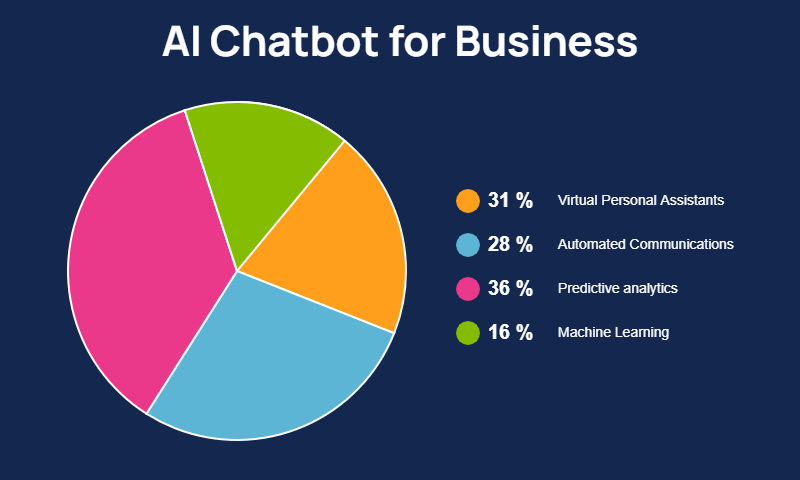Quick Links
Chatbots are software applications that use artificial intelligence (AI) and natural language processing (NLP) to simulate human conversations with customers. Chatbots can provide various benefits for businesses, such as improving customer experience, increasing sales, lead generation and reducing operational costs.
How Chatbots are Improving Customer Experience and Business Outcomes
Chatbots are software applications that use artificial intelligence (AI) and natural language processing (NLP) to simulate human conversations with customers. Chatbots can provide various benefits for businesses, such as improving customer experience, increasing sales, and reducing operational costs.
Chatbot Benefits for Businesses
Better open rates
Chatbots can proactively interact with the customers, delivering them quick responses and relevant information. Chatbots can also send notifications, reminders, and updates to customers, and increase their engagement and retention.
Better conversion rates
Chatbots can generate leads, recommend products, upsell and cross-sell, and facilitate transactions and payments. Chatbots can also provide personalized and tailored offers and suggestions, based on the customer’s preferences, behavior, and history.
Better customer satisfaction
Chatbots can provide 24/7 customer support, instant responses, personalized interactions, and easy access to information and services. Chatbots can also improve customer satisfaction, loyalty, and retention, by resolving issues, answering questions, and providing feedback.

Chatbot Benefits for Customers
Convenience and accessibility
Various platforms and devices, such as websites, mobile apps, social media, or messaging apps, enable access to chatbots. Chatbots can also provide customers with the convenience of getting the information and service they need, without having to wait, call, or visit a physical location.
Relevance and personalization
Chatbots can understand the customer’s intent, context, and sentiment, and provide relevant and personalized responses and solutions. Chatbots can also learn from the customer’s feedback and behavior, and improve their accuracy and reliability over time.
Empowerment and control
Chatbots can empower customers to make informed decisions, by providing them with options, comparisons, and recommendations. Chatbots can also give customers more control over their data and privacy, by asking for their consent and permission, and respecting their preferences and requests.
Fun and entertainment
Chatbots can provide customers with fun and entertainment, by adding humor, personality, and creativity to their interactions. Chatbots can also engage customers with games, quizzes, stories, and other interactive content. Chatbots can also surprise and delight customers with rewards, discounts, and incentives. Chatbots can also create a sense of connection and community, by connecting customers with other users or groups with similar interests or goals.
Education and awareness
Chatbots can provide customers with education and awareness, by providing them with useful and relevant information, tips, and advice. Chatbots can also help customers learn new skills, languages, or topics, by providing them with courses, tutorials, or resources. Chatbots can also raise customer awareness about social, environmental, or health issues, by providing them with facts, statistics, or stories. Chatbots can also inspire and motivate customers, by providing them with feedback, encouragement, or challenges.
Choice and flexibility
Chatbots can offer customers multiple options and channels to communicate and access information and services. Customers can choose the platform and device they prefer, such as websites, mobile apps, social media, or messaging apps. Customers can also choose the mode and style of communication they like, such as voice, text, or multimedia. Chatbots can also adapt to the customer’s pace and preferences, and switch between different topics and tasks.
Chatbots are improving customer experience and business outcomes, by providing various benefits, such as better open rates, conversion rates, and customer satisfaction. Chatbots are also enhancing customer service, by providing convenience, relevance, and empowerment to customers. Chatbots are not a replacement for human agents, but a complement and a partner, that can help businesses and customers achieve their goals and needs.
Chatbot Best Practices: How to Integrate Chatbots into Customer Service Effectively
Chatbots can be a powerful tool for customer service, but they also require careful planning and implementation. Here are some best practices for integrating chatbots into customer service effectively:
Define the chatbot's goals and scope
Before developing a chatbot, it is important to identify the chatbot’s goals and scope, such as the target audience, the use cases, the functionalities, and the metrics. This will help to design a chatbot that meets the customer’s needs and expectations, and aligns with the business objectives and strategy.
Choose the right chatbot platform
There are many chatbot platforms available in the market,Each platform has its own features, capabilities, and limitations. It is important to choose a chatbot platform that suits the chatbot’s goals and scope, and offers the necessary tools and support for building, testing, and deploying the chatbot.
Design the chatbot's conversation flow
The chatbot’s conversation flow is the sequence of messages and actions that the chatbot and the customer exchange during the interaction. The chatbot’s conversation flow should be clear, logical, and engaging, and follow the principles of conversational AI, such as natural language understanding, context awareness, and sentiment analysis. The chatbot’s conversation flow should also include error handling, fallback options, and feedback mechanisms, to ensure a smooth and satisfying customer experience.
Test and optimize the chatbot's performance
After developing the chatbot, it is essential to test and optimize the chatbot’s performance, such as the accuracy, speed, and reliability of the chatbot’s responses and actions. Conducting user testing, collecting feedback, and analyzing data and metrics can achieve this. Continuous monitoring and improvement of the chatbot’s performance should occur based on customer behavior and feedback, as well as changing market and customer needs.
Chatbot Challenges: How to Overcome the Limitations and Risks of Chatbots in Customer Service
Chatbots are not perfect, and they still face some limitations and risks that can affect their performance and reputation. Here are some of the common challenges that chatbots encounter in customer service, and how to overcome them:
Chatbot accuracy and reliability
Chatbots utilize natural language processing and machine learning to comprehend and reply to customer inquiries. However, these technologies are not flawless, and chatbots can sometimes misinterpret, misunderstand, or fail to answer customer questions. This can lead to customer frustration, dissatisfaction, and distrust.
To overcome this challenge, designers should design chatbots with clear and specific intents and scopes, and regularly test and train them to improve accuracy and reliability. Chatbots should also provide feedback mechanisms, such as ratings, surveys, or suggestions, to collect customer input and improve their performance. Chatbots should also have fallback options, such as transferring to a human agent, providing alternative resources, or apologizing and asking for clarification, to handle situations where they cannot provide a satisfactory answer.
Chatbot security and privacy
Chatbots often handle sensitive and personal information from customers, such as names, addresses, payment details, or preferences. This information can be vulnerable to cyberattacks, data breaches, or misuse by third parties. This can compromise customer security and privacy, and expose chatbots and businesses to legal and ethical issues.
To overcome this challenge, chatbots should follow the best practices and standards of data security and privacy, such as encryption, authentication, authorization, and compliance. Chatbots should also inform customers about the collection, storage, use, and sharing of their data, and obtain their consent and permission before accessing or processing their data.
Chatbots should also respect customer preferences and requests regarding their data, such as deleting, updating, or exporting their data. Such that as asking questions and collecting data from user should be simple and formal,so that user will get user-friendly chatbot customer service experience
Chatbot ethics and transparency
Chatbots can influence customer behavior and decisions, such as purchasing, subscribing, or rating. However, chatbots can also manipulate, deceive, or coerce customers, either intentionally or unintentionally, by providing biased, misleading, or false information. This can harm customer interests and rights, and damage chatbot and business credibility and reputation. To overcome this challenge, chatbots should follow the principles and guidelines of ethics and transparency, such as fairness, accountability, and explainability.
Chatbots should also disclose their identity and purpose, and avoid impersonating or pretending to be human. Chatbots should also provide accurate, relevant, and truthful information, and avoid promoting or endorsing products or services without customer consent or disclosure. By following these ethics user get best Chatbot customer service experience
Chatbot adoption rates will increase
According to a report by Juniper Research, the number of chatbot interactions in the retail, banking, and healthcare sectors will reach $3.6 billion globally by 2022, up from an estimated $2.8 million in 2017. This indicates that more and more businesses and customers will adopt chatbots as a preferred mode of communication and service delivery.
Chatbot technology will advance
Chatbot technology will continue to evolve and improve, with the help of emerging technologies, such as machine learning, deep learning, natural language generation, and computer vision. These technologies will enable chatbots to understand and generate more complex and natural language, handle more diverse and dynamic scenarios, and provide more rich and interactive experiences, such as voice, video, and image recognition and synthesis.
Chatbot customer service will become more human-like
Chatbots will become more human-like, not only in terms of their language and behavior, but also in terms of their personality and emotions. Chatbot customer service will be able to express and detect emotions, such as empathy, humor, and sarcasm, and adapt their tone and style to the customer’s mood and preference. Chatbots will also be able to develop and maintain long-term relationships with customers, and provide more personalized and tailored services and advice.
The future of chatbots in customer service
The future of chatbot customer service is promising. With advancements in AI and natural language processing, chatbots will become even more intelligent and intuitive, providing personalized and efficient support to customers. As businesses continue to prioritize automation and seamless customer experiences, chatbots will play an increasingly central role in shaping the future of customer service. From handling routine inquiries to predictive analytics and proactive problem-solving, chatbots will revolutionize how businesses interact with their customers, driving satisfaction and loyalty in the years to come.
Chatbot Examples: How Companies are Using Chatbots to Enhance Customer Service
Here are some chatbot examples from different industries and domains, and how they are improving customer service with chatbot technology.
Bank of America: A Financial Chatbot that Provides Banking Services and Advice
Bank of America is one of the largest banks in the United States, serving more than 66 million customers. Bank of America launched a chatbot on its mobile app, called Erica, that provides banking services and advice to customers. These chatbot customer service is to help customers check their balances, pay bills, transfer money, and monitor their spending habits.
The chatbot also offers personalized insights and guidance, such as saving tips, credit score updates, and debt reduction plans. Bank of America reported that the chatbot reached 10 million users within 18 months of its launch, and handled more than 100 million requests.

Domino's: A Pizza Chatbot that Simplifies Ordering and Delivery
Domino’s is a global pizza chain that delivers more than 3 million pizzas every day. Domino’s launched a chatbot on Facebook Messenger, called Dom, that enables customers to order pizzas and track their delivery status. The chatbot also offers coupons and deals, and answers frequently asked questions. Domino’s reported that the chatbot increased the conversion rate by 3.6%, and reduced the average order time by 4 minutes.
Starbucks: A Coffee Chatbot that Simplifies Ordering and Payment
Starbucks is a global coffee chain that serves millions of customers every day. Starbucks launched a chatbot on its mobile app, called My Starbucks Barista, that allows customers to order and pay for their drinks and food using voice or text commands. The chatbot also provides nutritional information, menu suggestions, and loyalty rewards. Starbucks reported that the chatbot increased the convenience and speed of ordering and payment, and enhanced the customer experience.
Duolingo: A Language Chatbot that Provides Learning and Practice Opportunities
Duolingo is a popular language learning platform that offers courses in over 30 languages. Duolingo launched a chatbot on its mobile app, called Duolingo Bots, that provides learning and practice opportunities for customers. The chatbot simulates real-life conversations with native speakers, and adapts to the customer’s skill level and feedback. Duolingo reported that the chatbot improved the learning outcomes and motivation of customers, and reduced the anxiety and boredom of language learning.
Conclusion
Looking to revolutionize your customer service with cutting-edge chatbot technology? Reach WayMore for a complimentary consultation and live demo.
Start improving customer service with chatbots today! Contact us for a free demo.
WayMore chatbot platform empowers businesses across various sectors – from e-commerce to healthcare and beyond – to effortlessly create, fine-tune, and elevate their customer service experiences.
If you want to learn more, reach out to the experts at WayMore today.




